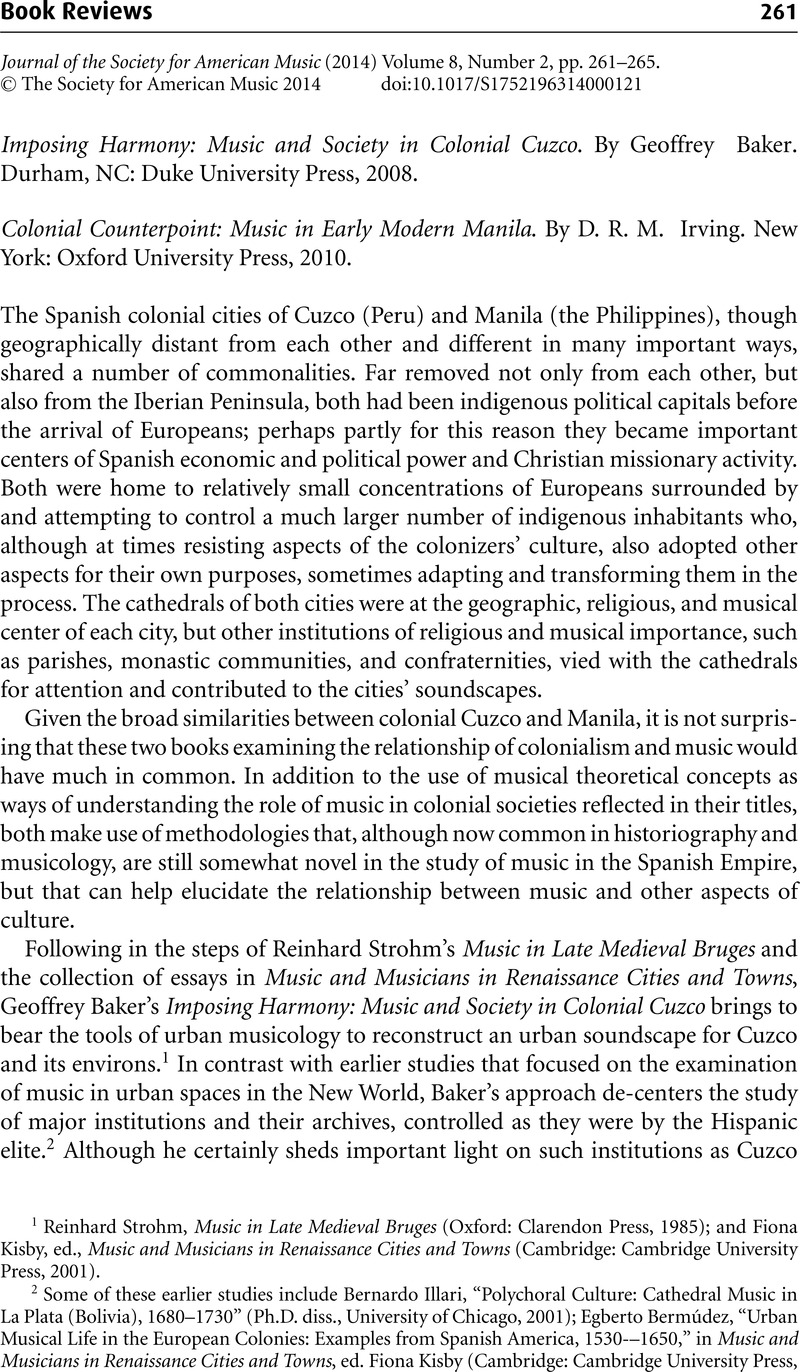No CrossRef data available.
Article contents
Imposing Harmony: Music and Society in Colonial Cuzco. By Geoffrey Baker. Durham, NC: Duke University Press, 2008. - Colonial Counterpoint: Music in Early Modern Manila. By D. R. M. Irving. New York: Oxford University Press, 2010.
Published online by Cambridge University Press: 04 June 2014
Abstract

- Type
- Book Review
- Information
- Journal of the Society for American Music , Volume 8 , Issue 2: Musical Women in Nineteenth-Century America , May 2014 , pp. 261 - 265
- Copyright
- Copyright © The Society for American Music 2014
References
1 Strohm, Reinhard, Music in Late Medieval Bruges (Oxford: Clarendon Press, 1985)Google Scholar; and Kisby, Fiona, ed., Music and Musicians in Renaissance Cities and Towns (Cambridge: Cambridge University Press, 2001)Google Scholar.
2 Some of these earlier studies include Bernardo Illari, “Polychoral Culture: Cathedral Music in La Plata (Bolivia), 1680–1730” (Ph.D. diss., University of Chicago, 2001); Bermúdez, Egberto, “Urban Musical Life in the European Colonies: Examples from Spanish America, 1530–1650,” in Music and Musicians in Renaissance Cities and Towns, ed. Kisby, Fiona (Cambridge: Cambridge University Press, 1999), 167–80Google Scholar; and Estenssoro, Juan Carlos, Música y sociedad coloniales: Lima, 1690–1830 (Lima: Editorial Colmillo Blanco, 1989)Google Scholar. Important additions to these earlier studies are the essays collected in Baker, Geoffrey and Knighton, Tess, ed., Music and Urban Society in Early Colonial Latin America (Cambridge: Cambridge University Press, 2011)Google Scholar.
3 Important earlier studies include Ugarte, Rubén Vargas, “Un archivo de música colonial en la ciudad del Cuzco,” Mar del Sur 5/26 (1953): 1–10Google Scholar; Stevenson, Robert, Music in Aztec and Inca Territory (Berkeley: University of California Press, 1968)Google Scholar; Stevenson, “Cuzco Cathedral: 1546–1750,” Inter-American Music Review 2/2 (1980): 1–25; Valdés, Samuel Claro, “Música dramatica en el Cuzco durante el siglo XVIII y catálogo de manuscritos de música del Seminario de San Antonio Abad (Cuzco, Perú),” Yearbook of the Inter-American Institute for Musical Research 5 (1969): 1–48Google Scholar.
4 Burns, Kathryn, Colonial Habits: Convents and the Spiritual Economy of Cuzco, Peru (Durham, NC: Duke University Press, 1999)Google Scholar; and Burns, “Beatas, ‘decencia’ y poder: La formación de una elite indígena en el Cuzco colonial,” in Incas e indios cristianos: Elites indígenas e identidades cristianas en los Andes coloniales, ed. Jean-Jacques Decoster (Cuzco: Centro de Estudios Regionales Andinos Bartolomé de las Casas, 2002), 121–34.
5 Said, Edward W., Culture and Imperialism (New York: Knopf, 1993)Google Scholar.
6 The Philippines’ later political connections with the United States also lent itself to cultural connections. Manila was the capital of the U.S.-dominated Insular Government (1902–35) and the U.S. Commonwealth of the Philippines (1935–46). (The Commonwealth Government was in exile during the Japanese occupation of the Philippines during World War II.)


